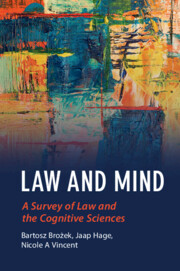Book contents
- Law and Mind
- Law and the Cognitive Sciences
- Law and Mind
- Copyright page
- Contents
- Figures
- Contributors
- Acknowledgements
- 1 Introduction
- I Metatheory and Methodology
- II Ontology and Epistemology
- 6 Cognitive Science and the Nature of Law
- 7 The Architecture of the Legal Mind
- 8 The Psychology of the Trial Judge
- 9 Institutional Design and the Psychology of the Trial Judge
- 10 Bias at the Surface or the Core? A Comment on the Psychology of the Trial Judge
- III Legal Doctrine and Cognitive Sciences
- IV Evidence
- V Dissenting Opinions
- References
6 - Cognitive Science and the Nature of Law
from II - Ontology and Epistemology
Published online by Cambridge University Press: 21 April 2021
- Law and Mind
- Law and the Cognitive Sciences
- Law and Mind
- Copyright page
- Contents
- Figures
- Contributors
- Acknowledgements
- 1 Introduction
- I Metatheory and Methodology
- II Ontology and Epistemology
- 6 Cognitive Science and the Nature of Law
- 7 The Architecture of the Legal Mind
- 8 The Psychology of the Trial Judge
- 9 Institutional Design and the Psychology of the Trial Judge
- 10 Bias at the Surface or the Core? A Comment on the Psychology of the Trial Judge
- III Legal Doctrine and Cognitive Sciences
- IV Evidence
- V Dissenting Opinions
- References
Summary
Law is not simply a matter of rules: it is also a domain of facts and objects, and explaining these facts – their nature and structure, and more in general the nature of law – is a crucial problem of jurisprudence. There is a relevant and quite intuitive sense in which social facts can be assumed to depend on the mental states of individuals. The features of this dependence, and the kinds of mental states involved, are two separate questions – the first metaphysical, the second psychological – which are, however, deeply intertwined. For this reason, legal metaphysics is inevitably an interdisciplinary research connected with cognitive psychology: it is not possible to have a clear idea of the nature of legal facts without understanding the cognitive underpinnings of the mental states those facts depend on.In this chapter, I will adopt this interdisciplinary approach and try to outline a picture, however tentative and incomplete, of the psychological problems and findings that are relevant for research in the metaphysics of law. The chapter is based on two separate assumptions, which I will put forward as my analytical framework. The first assumption is that legal facts are a subset of social fact: hence, legal metaphysics is a subset of social metaphysics. The second assumption is that legal institutions are peculiar social institutions that put in place a framework consisting of sanctions, along with the authority to define, apply, and enforce shared rules of conduct in a formal way. The analytical framework that I derive from these two assumptions will make it possible to distinguish two aspects of law: one is the law’s root in collective acceptance, the other is its structure, namely, a framework of sanctions and power/authority. Both these aspects ultimately trace back to cognitive mechanisms. The discussion is organized accordingly. I will first deal with the root of law, then with its structure, and for each aspect I will first present its conceptual and theoretical background and then describe the connected cognitive-psychological studies and topics of research.
- Type
- Chapter
- Information
- Law and MindA Survey of Law and the Cognitive Sciences, pp. 99 - 137Publisher: Cambridge University PressPrint publication year: 2021
References
- 2
- Cited by



